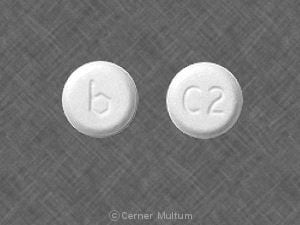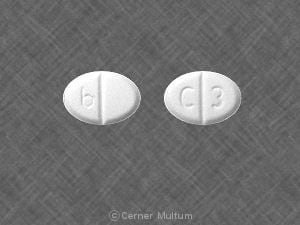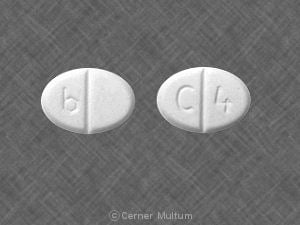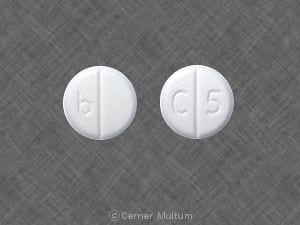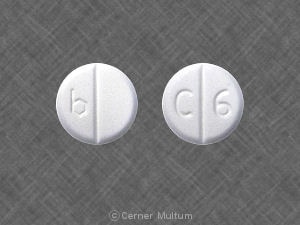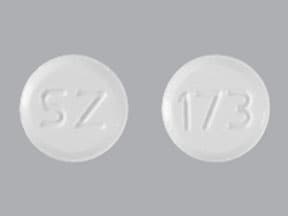Dosage Forms
Excipient information presented when available (limited, particularly for generics); consult specific product labeling.
Tablet, Oral, as dihydrochloride monohydrate:
Mirapex: 0.125 mg [contains corn starch]
Mirapex: 0.25 mg, 0.5 mg [scored; contains corn starch]
Mirapex: 0.75 mg [contains corn starch]
Mirapex: 1 mg, 1.5 mg [scored; contains corn starch]
Generic: 0.125 mg, 0.25 mg, 0.5 mg, 0.75 mg, 1 mg, 1.5 mg
Tablet Extended Release 24 Hour, Oral, as dihydrochloride monohydrate:
Mirapex ER: 0.375 mg, 0.75 mg, 1.5 mg, 2.25 mg, 3 mg, 3.75 mg, 4.5 mg [contains corn starch]
Generic: 0.375 mg, 0.75 mg, 1.5 mg, 2.25 mg, 3 mg, 3.75 mg, 4.5 mg
Pharmacology
Mechanism of Action
Pramipexole is a nonergot dopamine agonist with specificity for the D2 subfamily dopamine receptor, and has also been shown to bind to D3 and D4 receptors. By binding to these receptors, it is thought that pramipexole can stimulate dopamine activity on the nerves of the striatum and substantia nigra.
Pharmacokinetics/Pharmacodynamics
Absorption
Rapid
Distribution
Vd: 500 L
Metabolism
Negligible (<10%)
Excretion
Urine (90% as unchanged drug)
Time to Peak
Serum: Immediate release: ~2 hours; Extended release: 6 hours
Half-Life Elimination
8.5 hours; Elderly: 12 hours
Protein Binding
~15%
Use in Specific Populations
Special Populations: Renal Function Impairment
Clearance is 75% lower with severe impairment (CrCl ~20 mL/min) and approximately 60% lower with moderate impairment (CrCl ~40 mL/min).
Special Populations: Elderly
The half-life increases approximately 40% and clearance decreases approximately 30% in patients 65 years and older mostly because of reduced renal function with age.
Special Populations: Gender
Clearance is approximately 30% lower in women.
Use: Labeled Indications
Parkinson disease: Treatment of Parkinson disease.
Restless legs syndrome (immediate release only): Treatment of moderate to severe primary restless legs syndrome (RLS).
Contraindications
There are no contraindications listed in the manufacturer's labeling.
Canadian labeling: Hypersensitivity to pramipexole or any component of the formulation.
Dosage and Administration
Dosing: Adult
Note: Retitration of dose should be considered for any significant interruption in therapy.
Parkinson disease: Oral:
Immediate release: Initial: 0.125 mg 3 times daily, increase gradually every 5 to 7 days; maintenance (usual): 0.5 to 1.5 mg 3 times daily
Discontinuation of therapy: Reduce dose by 0.75 mg per day until daily dose is equivalent to 0.75 mg once daily, then reduce by 0.375 mg per day thereafter
Extended release: Initial: 0.375 mg once daily; increase gradually not more frequently than every 5 to 7 days to 0.75 mg once daily and then (if necessary) by 0.75 mg per dose; maximum: 4.5 mg once daily.
Discontinuation of therapy: Reduce dose by 0.75 mg per day until daily dose is equivalent to 0.75 mg once daily, then reduce by 0.375 mg per day thereafter.
Converting from immediate release to extended release: May initiate extended-release tablet the morning after the last immediate-release evening tablet is taken. The total daily dose should remain the same.
Restless legs syndrome: Oral: Immediate release: Initial: 0.125 mg once daily 2 to 3 hours before bedtime. Dose may be doubled every 4 to 7 days up to 0.5 mg once daily. Alternatively, a maximum dose of 0.75 mg/day has been recommended (Garcia-Borreguero 2016). Note: If augmentation occurs, dose earlier in the day, divide into multiple daily doses, or consider switching to alternative therapy (Garcia-Borreguero 2016).
Discontinuation of therapy: Worsening of symptoms may occur with abrupt discontinuation; a gradual dose reduction every 4 to 7 days has been recommended (Mirapex Canadian product labeling).
Dosing: Geriatric
Refer to adult dosing.
Administration
Administer with or without food; administer with food to decrease nausea. ER tablets should be swallowed whole and not chewed, crushed, or divided. For restless legs syndrome, administer 2 to 3 hours before bedtime; if augmentation occurs, dose earlier in the day, divide into multiple daily doses, or consider switching to alternative therapy (Garcia-Borreguero 2016).
Dietary Considerations
May be taken with or without food. May be taken with food to decrease nausea.
Storage
Store at 25°C (77°F); excursions permitted to 15°C to 30°C (59°F to 86°F). Protect from light and high humidity.
Pramipexole Images
Drug Interactions
Alcohol (Ethyl): May enhance the sedative effect of Pramipexole. Monitor therapy
Alfuzosin: May enhance the hypotensive effect of Blood Pressure Lowering Agents. Monitor therapy
Alizapride: May diminish the therapeutic effect of Anti-Parkinson Agents (Dopamine Agonist). Avoid combination
Amifostine: Blood Pressure Lowering Agents may enhance the hypotensive effect of Amifostine. Management: When amifostine is used at chemotherapy doses, blood pressure lowering medications should be withheld for 24 hours prior to amifostine administration. If blood pressure lowering therapy cannot be withheld, amifostine should not be administered. Consider therapy modification
Amisulpride: May diminish the therapeutic effect of Anti-Parkinson Agents (Dopamine Agonist). Anti-Parkinson Agents (Dopamine Agonist) may diminish the therapeutic effect of Amisulpride. Avoid combination
Antipsychotic Agents (First Generation [Typical]): May diminish the therapeutic effect of Anti-Parkinson Agents (Dopamine Agonist). Anti-Parkinson Agents (Dopamine Agonist) may diminish the therapeutic effect of Antipsychotic Agents (First Generation [Typical]). Management: Avoid concomitant therapy if possible and monitor for decreased effects of both agents when these combinations cannot be avoided. Atypical antipsychotics such as clozapine and quetiapine may be less likely to reduce the effects of anti-Parkinson agents. Consider therapy modification
Antipsychotic Agents (Second Generation [Atypical]): May diminish the therapeutic effect of Anti-Parkinson Agents (Dopamine Agonist). Management: Consider using an alternative antipsychotic agent when possible in patients with Parkinson disease. If an atypical antipsychotic is necessary, consider using clozapine or quetiapine, which may convey the lowest interaction risk. Consider therapy modification
Blood Pressure Lowering Agents: May enhance the hypotensive effect of Hypotension-Associated Agents. Monitor therapy
Brimonidine (Topical): May enhance the hypotensive effect of Blood Pressure Lowering Agents. Monitor therapy
Bromopride: May diminish the therapeutic effect of Anti-Parkinson Agents (Dopamine Agonist). Monitor therapy
Bromperidol: Blood Pressure Lowering Agents may enhance the hypotensive effect of Bromperidol. Bromperidol may diminish the hypotensive effect of Blood Pressure Lowering Agents. Avoid combination
BuPROPion: Anti-Parkinson Agents (Dopamine Agonist) may enhance the adverse/toxic effect of BuPROPion. Monitor therapy
Cimetidine: May increase the serum concentration of Pramipexole. Monitor therapy
CNS Depressants: May enhance the sedative effect of Pramipexole. Monitor therapy
Diazoxide: May enhance the hypotensive effect of Blood Pressure Lowering Agents. Monitor therapy
DULoxetine: Blood Pressure Lowering Agents may enhance the hypotensive effect of DULoxetine. Monitor therapy
Herbs (Hypotensive Properties): May enhance the hypotensive effect of Blood Pressure Lowering Agents. Monitor therapy
Hypotension-Associated Agents: Blood Pressure Lowering Agents may enhance the hypotensive effect of Hypotension-Associated Agents. Monitor therapy
Levodopa-Containing Products: Blood Pressure Lowering Agents may enhance the hypotensive effect of Levodopa-Containing Products. Monitor therapy
Lormetazepam: May enhance the hypotensive effect of Blood Pressure Lowering Agents. Monitor therapy
Methylphenidate: May enhance the adverse/toxic effect of Anti-Parkinson Agents (Dopamine Agonist). Monitor therapy
Metoclopramide: May diminish the therapeutic effect of Anti-Parkinson Agents (Dopamine Agonist). Monitor therapy
Molsidomine: May enhance the hypotensive effect of Blood Pressure Lowering Agents. Monitor therapy
Naftopidil: May enhance the hypotensive effect of Blood Pressure Lowering Agents. Monitor therapy
Nicergoline: May enhance the hypotensive effect of Blood Pressure Lowering Agents. Monitor therapy
Nicorandil: May enhance the hypotensive effect of Blood Pressure Lowering Agents. Monitor therapy
Nitroprusside: Blood Pressure Lowering Agents may enhance the hypotensive effect of Nitroprusside. Monitor therapy
Obinutuzumab: May enhance the hypotensive effect of Blood Pressure Lowering Agents. Management: Consider temporarily withholding blood pressure lowering medications beginning 12 hours prior to obinutuzumab infusion and continuing until 1 hour after the end of the infusion. Consider therapy modification
Pentoxifylline: May enhance the hypotensive effect of Blood Pressure Lowering Agents. Monitor therapy
Pholcodine: Blood Pressure Lowering Agents may enhance the hypotensive effect of Pholcodine. Monitor therapy
Phosphodiesterase 5 Inhibitors: May enhance the hypotensive effect of Blood Pressure Lowering Agents. Monitor therapy
Prostacyclin Analogues: May enhance the hypotensive effect of Blood Pressure Lowering Agents. Monitor therapy
Quinagolide: May enhance the hypotensive effect of Blood Pressure Lowering Agents. Monitor therapy
Solriamfetol: Anti-Parkinson Agents (Dopamine Agonist) may enhance the hypertensive effect of Solriamfetol. Monitor therapy
Sulpiride: May diminish the therapeutic effect of Anti-Parkinson Agents (Dopamine Agonist). Avoid combination
Adverse Reactions
Actual frequency may be dependent on dose, formulation, and/or concomitant levodopa. All adverse reactions are as reported for Parkinson disease (PD) unless otherwise noted.
>10%:
Cardiovascular: Orthostatic hypotension (3% to 53%)
Central nervous system: Drowsiness (PD: 9% to 36%; RLS: 6%), extrapyramidal reaction (28%), insomnia (PD: 4% to 27%; RLS: 13%), dizziness (2% to 26%), hallucination (5% to 17%; includes auditory, visual, and mixed hallucinations), headache (RLS: 16%; PD: 4% to 7%), restless leg syndrome (10% to 12%; includes augmentation, rebound, worsening), abnormal dreams (PD and RLS: 8% to 11%)
Gastrointestinal: Nausea (PD and RLS: 11% to 28%), constipation (PD: 6% to 14%; RLS: 4%)
Neuromuscular & skeletal: Dyskinesia (17% to 47%), asthenia (3% to 14%)
Miscellaneous: Accidental injury (17%)
1% to 10%:
Cardiovascular: Peripheral edema (2% to 8%), edema (4% to 5%), chest pain (3%)
Central nervous system: Confusion (4% to 10%), fatigue (PD and RLS: 6% to 9%), dystonia (2% to 8%), abnormal gait (7%), hypertonia (7%), amnesia (4% to 6%), sleep disorder (1% to 6%; includes sleep attacks), falling (4%), impulse control disorder (3% to 4%; eg, binge eating, compulsive shopping, hypersexuality, pathological gambling), vertigo (2% to 4%), hypoesthesia (3%), abnormality in thinking (2% to 3%), akathisia (2% to 3%), malaise (2% to 3%), depression (2%), equilibrium disturbance (2%), paranoia (2%), delusions (1%), myasthenia (1%), myoclonus (1%)
Dermatologic: Dermatologic disorders (2%)
Endocrine & metabolic: Weight loss (2%), decreased libido (1%)
Gastrointestinal: Xerostomia (PD and RLS: 3% to 7%), diarrhea (RLS: 1% to 7%; PD: 2%), anorexia (4% to 5%), vomiting (4%), upper abdominal pain (3% to 4%), dyspepsia (3%), increased appetite (2% to 3%), dysphagia (2%), sialorrhea (2%), abdominal distress (1% to 2%)
Genitourinary: Urinary frequency (6%), urinary tract infection (4%), impotence (2%), urinary incontinence (2%)
Infection: Influenza (RLS: 3% to 7%)
Neuromuscular & skeletal: Limb pain (RLS: 3% to 7%), muscle spasm (5%), arthritis (3%), tremor (3%), back pain (2% to 3%), bursitis (2%), twitching (2%), increased creatine phosphokinase (1%)
Ophthalmic: Accommodation disturbance (4%), visual disturbance (3%), diplopia (1%)
Respiratory: Nasal congestion (RLS: 3% to 6%), dyspnea (4%), cough (3%), rhinitis (3%), pneumonia (2%)
Miscellaneous: Fever (1%)
<1%, postmarketing, and/or case reports: Abnormal stools (ER tablet residue; may be associated with worsening of PD symptoms), abnormal posture (postural deformities including antecollis, captocormia [Bent Spine syndrome], pleurothonus [Pisa syndrome]), aggressive behavior, agitation, altered mental status, behavioral changes, cardiac failure, delirium, disorientation, erythema, pruritus, psychotic symptoms, pulmonary fibrosis, retroperitoneal fibrosis, rhabdomyolysis, SIADH, skin rash, syncope, urticaria, weight gain
Warnings/Precautions
Concerns related to adverse effects:
- Dyskinesias: May cause or exacerbate dyskinesias. Use with caution in patients with preexisting dyskinesias.
- Impulse control disorders: Has been associated with compulsive behaviors and/or loss of impulse control, which has manifested as pathological gambling, compulsive buying, libido increases (hypersexuality), binge eating, and/or other intense urges. Dose reduction or discontinuation of therapy has been reported to reverse these behaviors in some, but not all cases.
- Neuroleptic malignant syndrome: Dopaminergic therapy has been reported to cause symptoms resembling neuroleptic malignant syndrome (altered consciousness, autonomic instability, elevated temperature, and muscular rigidity) associated with rapid dose reduction, discontinuation, or changes in therapy; taper dose to decrease risk of hyperpyrexia and confusion.
- Orthostatic hypotension: May cause orthostatic hypotension; Parkinson disease patients appear to have an impaired capacity to respond to a postural challenge. Use with caution in patients at risk of hypotension (such as those receiving antihypertensive drugs) or where transient hypotensive episodes would be poorly tolerated (cardiovascular disease or cerebrovascular disease). Parkinson disease and RLS patients being treated with dopaminergic agonists ordinarily require careful monitoring for signs and symptoms of postural hypotension, especially during dose escalation, and should be informed of this risk.
- Pleural/retroperitoneal fibrosis: Ergot-derived dopamine agonists have been associated with fibrotic complications (eg, retroperitoneal fibrosis, pleural effusion, pleural thickening, pulmonary infiltrates, pericarditis, cardiac valvulopathy). Although pramipexole is not an ergot, there have been postmarketing reports of possible fibrotic complications (peritoneal, pleural, pulmonary) with pramipexole; monitor closely for signs and symptoms of fibrosis. Discontinuation of therapy may resolve complications, but not in all cases.
- Postural deformity: Postural deformities, including antecollis, camptocormia (Bent Spine Syndrome) and pleurothotonus (Pisa Syndrome) have been reported following initiation, several months into treatment, or after increasing the dose. Consider dose reduction or treatment discontinuation in patients who develop postural deformity (complications may improve).
- Psychotic effects: May cause or exacerbate mental status and behavioral changes, which may be severe, including psychotic-like behavior during treatment or after starting or increasing the dose; manifestations may include paranoid ideation, delusions, hallucinations, confusion, psychotic-like behavior, disorientation, aggressive behavior, agitation, and delirium. Avoid use in patients with a major psychotic disorder. Older adults may be at a higher risk for hallucinations.
- Retinal changes: Pathologic degenerative changes were observed in the retinas of albino rats during studies with this agent, but were not observed in the retinas of albino mice or in other species. The significance of these data for humans remains uncertain.
- Somnolence: Patients have reported falling asleep while engaging in activities of daily living; this has been reported to occur without significant warning signs; some of these events had been reported one year after the initiation of therapy. Before initiating treatment, advise patients of the potential to develop drowsiness, and inquire about factors that may increase the risk (eg, concomitant sedating medications and/or alcohol, presence of sleep disorders, concomitant medications that increase pramipexole plasma levels). Patients must be cautioned about performing tasks which require mental alertness (eg, operating machinery or driving). Monitor for daytime somnolence or preexisting sleep disorder; discontinue if significant daytime sleepiness or episodes of falling asleep occur; if a decision is made to continue therapy, advise patients not to drive and to avoid other potentially dangerous activities. Pramipexole has been associated with somnolence.
Disease-related concerns:
- Heart failure (HF): A pooled analysis of randomized, placebo-controlled phase 2 and 3 clinical trials demonstrated a more frequent incidence of newly diagnosed HF (not statistically significant) in patients receiving pramipexole compared with patients receiving placebo (0.28% [12/4,157] vs 0.14% [4/2,820], respectively) (FDA Drug Safety Communication 2012) . Two epidemiologic studies have also suggested an increased incidence of HF. The first epidemiologic study, a case-control study in a United Kingdom cohort of patients receiving anti-Parkinson agents (eg, dopamine agonists), revealed a statistically significant increased risk for HF in patients exposed to any dopamine agonist compared with no exposure (RR: 1.58; 95% CI: 1.26 to 1.96) with pramipexole being associated with a statistically significant increased risk of HF versus no exposure (RR: 1.86; 95% CI: 1.21 to 2.85) (Renoux 2012). In the second epidemiologic study, a case-control study in a cohort of Parkinson disease patients newly initiated on a dopamine agonist or levodopa, found that among the individual non-ergot dopamine agonists studied, only current use of pramipexole was associated with an increased risk of HF compared with levodopa use (OR: 1.61; 95% CI: 1.09 to 2.38). This increased risk occurred in the first 3 months of treatment (OR: 3.06; 95% CI: 1.74 to 5.39) and in patients ≥80 years of age (OR: 3.30; 95% CI: 1.62 to 7.13). Of note, the increased risk was not significant with pramipexole use >3 months (Mokhles 2012). The FDA has not concluded that pramipexole increases the risk of HF. Due to study limitations and the potential for confounders, the FDA is continuing its review. Monitor for signs and symptoms of heart failure. In a scientific statement from the American Heart Association, pramipexole has been determined to be an agent that may cause direct myocardial toxicity (magnitude: major) (AHA [Page 2016]).
- Renal impairment: Use with caution in patients with renal impairment; dose adjustment may be necessary. Extended-release tablets are not recommended for use in patients with CrCl <30 mL/minute or ESRD requiring hemodialysis.
- Restless legs syndrome: Augmentation (earlier onset of symptoms in the evening/afternoon, increase and/or spread of symptoms to other extremities) may occur in some restless leg syndrome (RLS) patients. Risk factors for dopaminergic-induced augmentation include higher doses of dopaminergic agents, use of shorter-acting dopamine agonists (ie, pramipexole, ropinirole) or levodopa, low iron stores, and increased severity of symptoms prior to treatment initiation. To minimize risk of augmentation, treatment should only be initiated when symptoms significantly impact quality of life; intermittent treatment should also be considered. If dopaminergic agents are used as initial treatment, use the lowest effective dose and avoid exceeding recommended doses. If augmentation occurs, dose earlier in the day, divide into multiple daily doses, or consider switching to alternative therapy. End-of-dose rebound (reappearance of symptoms in the early morning hours that are worse than baseline) may also occur (Garcia-Borreguero 2016). Consider dosage adjustment or discontinuation of treatment if rebound symptoms occur.
Concurrent drug therapy issues:
- Drug-drug interactions: Potentially significant interactions may exist, requiring dose or frequency adjustment, additional monitoring, and/or selection of alternative therapy. Consult drug interactions database for more detailed information.
Special populations:
- Elderly: May be prone to an increased risk of adverse drug reactions.
Dosage form specific issues:
- Extended-release tablet: Tablet residue resembling a swollen whole or partial tablet may be visible in the stool after taking the extended-release formulation. Some patients reported a worsening of their Parkinson disease symptoms when tablet residue was observed.
Other warnings/precautions:
- Discontinuation of therapy: Taper gradually when discontinuing therapy in patients with Parkinson disease; dopaminergic agents have been associated with a syndrome resembling neuroleptic malignant syndrome on abrupt withdrawal or significant dosage reduction after long-term use.
Monitoring Parameters
Blood pressure, heart rate (especially during dose escalation); body weight changes; CNS depression, fall risk, behavior changes (eg, compulsive behaviors); periodic skin examinations.
Pregnancy
Pregnancy Considerations
Information related to the use of pramipexole for the treatment of Parkinson disease (Benbir 2013; Lamichhane 2014; Mucchiut 2004; Tüfekçioglu 2018) or restless legs syndrome (RLS) (Dostal 2013) in pregnant women is limited. Current guidelines note that the available information is insufficient to make a recommendation for the treatment of RLS in pregnant women (Aurora 2012).
Patient Education
What is this drug used for?
- It is used to treat Parkinson disease.
- It is used to treat restless leg syndrome.
- It may be given to you for other reasons. Talk with the doctor.
Frequently reported side effects of this drug
- Headache
- Nausea
- Constipation
- Trouble sleeping
- Dry mouth
- Loss of strength and energy
- Nightmares
- Diarrhea
- Muscle spasms
- Weight loss
- Stuffy nose
Other side effects of this drug: Talk with your doctor right away if you have any of these signs of:
- Uncontrollable urges
- Confusion
- Stiff muscles
- Passing a lot of urine
- Severe dizziness
- Passing out
- Sweating a lot
- Shortness of breath
- Excessive weight gain
- Swelling of arms or legs
- Vision changes
- Abnormal movements
- Difficulty moving
- Sensing things that seem real but are not
- Trouble with memory
- Muscle pain
- Muscle weakness
- Behavioral changes
- Mood changes
- Narcolepsy
- Severe fatigue
- Changes in posture
- Restless leg syndrome
- Signs of a significant reaction like wheezing; chest tightness; fever; itching; bad cough; blue skin color; seizures; or swelling of face, lips, tongue, or throat.
Note: This is not a comprehensive list of all side effects. Talk to your doctor if you have questions.
Consumer Information Use and Disclaimer: This information should not be used to decide whether or not to take this medicine or any other medicine. Only the healthcare provider has the knowledge and training to decide which medicines are right for a specific patient. This information does not endorse any medicine as safe, effective, or approved for treating any patient or health condition. This is only a brief summary of general information about this medicine. It does NOT include all information about the possible uses, directions, warnings, precautions, interactions, adverse effects, or risks that may apply to this medicine. This information is not specific medical advice and does not replace information you receive from the healthcare provider. You must talk with the healthcare provider for complete information about the risks and benefits of using this medicine.
